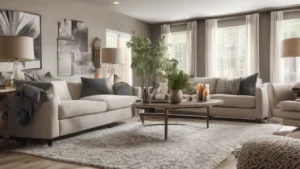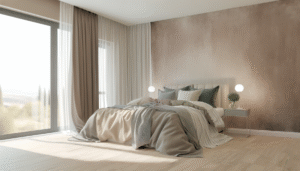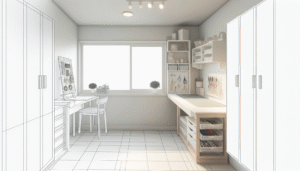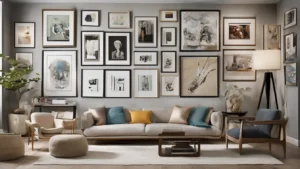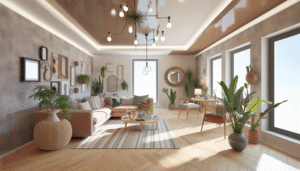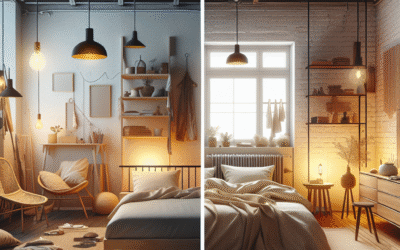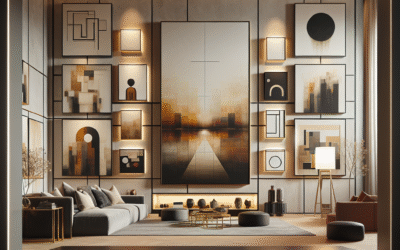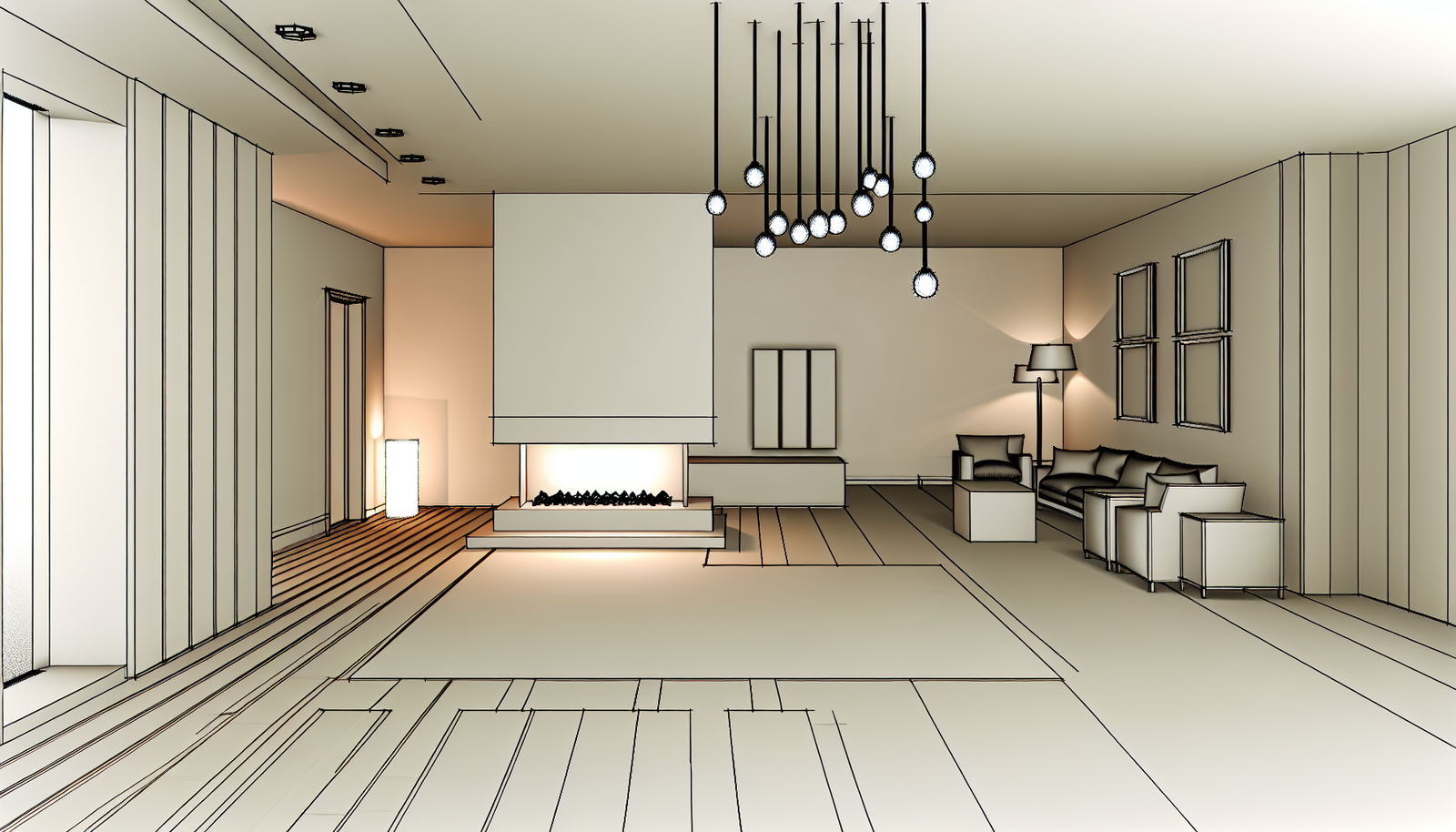
In the contemporary home, the fireplace is no longer just a source of heat; it’s a statement piece, an architectural element that embodies style and sophistication. For those who appreciate clean lines, uncluttered spaces, and purposeful elegance, modern fireplaces with minimal design offer the perfect blend of warmth and aesthetics.
Gone are the days of bulky, ornate hearths dominating a room. Today’s minimalist fire features are designed to integrate seamlessly into a modern living environment, often becoming a focal point through their understated beauty rather than overt grandeur. This guide delves deep into the world of minimalist fireplace design, exploring the principles, types, benefits, and practical considerations that will help you select or create the ideal sleek fire feature for your space.
From the subtle flicker behind a glass panel to the bold, linear flame that defines a room, we’ll uncover how these innovative designs merge functionality with aesthetic purity. You’ll learn about various fuel types, installation options, smart home integration, and the crucial aspects of safety and maintenance. Prepare to transform your understanding of what a fireplace can be, moving beyond tradition to embrace the elegant simplicity of modern minimalist design. By the end of this article, you’ll have a comprehensive understanding of how to achieve that perfect ambiance, turning your living area into a haven of contemporary warmth.
Article Roadmap: We’ll explore the essence of minimalist design, delve into different types of modern fireplaces, discuss aesthetic and functional benefits, cover critical installation and safety considerations, and finally, provide practical advice for integrating these stunning features into your home.
Embracing Minimalism: The Core Philosophy Behind Modern Fireplaces
Minimalism isn’t just an aesthetic; it’s a philosophy that champions simplicity, functionality, and clarity. It’s about stripping away the superfluous to reveal the essential. When applied to fireplace design, this means a focus on clean lines, neutral colors, natural materials, and an emphasis on the flame itself as the primary art form. A truly minimalist fireplace doesn’t compete with its surroundings; it enhances them, acting as a serene anchor in a well-considered space.
Defining Minimalist Fireplace Aesthetics
What exactly makes a fireplace ‘minimalist’? It’s often characterized by several key design elements:
- Clean Lines and Geometric Shapes: Absence of ornamentation, intricate carvings, or busy profiles. Think sleek rectangles, sophisticated squares, or elegant linear forms.
- Integrated Design: Rather than a standalone unit, minimalist fireplaces are often built into the wall, furniture, or architectural features, creating a cohesive and flush appearance. This can include flush-mounted inserts or fireplaces integrated into media units.
- Subtle Material Palette: Materials like concrete, polished stone (marble, granite, limestone), steel, glass, and smooth plaster are preferred. These materials offer textural interest without visual clutter.
- Focus on the Flame: With minimal distraction from the surround, the dancing flames become the central focus, providing a meditative and captivating experience. This is especially true for linear burners that create a continuous line of fire.
- Neutral and Earthy Tones: White, grey, black, and natural wood tones dominate, ensuring the fireplace can blend seamlessly with various interior design schemes.
- Hidden Components: Vents, controls, and ancillary elements are often cleverly concealed to maintain an uninterrupted facade.
The Evolution of Fireplace Design: From Ornate to Understated
Historically, fireplaces were grand, often heavily decorated symbols of status and wealth, built for practicality but also for showing off. Think of the elaborate Victorian hearths or the sprawling, rustic stone fireplaces of country homes. While beautiful in their own right, they often commanded the entire visual attention of a room.
The shift towards modern and minimalist design began in the 20th century, influenced by movements like Bauhaus and Scandinavian modernism. Designers started to prioritize functionality and simplicity, leading to fireplaces that were less about embellishment and more about efficient heating and integrated aesthetics. Today, this evolution has culminated in the sophisticated, discreet units that define modern fireplaces with minimal design. They reflect a contemporary desire for uncluttered living, where every element serves a purpose and contributes to overall serenity.
Types of Modern Fireplaces with Minimal Design
Modern fireplace design offers an astonishing array of types, each bringing a unique blend of form and function to the minimalist aesthetic. Understanding these categories is crucial for making an informed decision about the best fit for your home’s structure and your personal preference.
1. Wall-Mounted (Recessed or Hung) Fireplaces
These are perhaps the most quintessential example of modern minimalism. Wall-mounted fireplaces are designed to either be recessed flush into a wall, creating an almost invisible boundary between the fire and the architecture, or hung on the wall like a piece of art.
- Recessed (Built-in): The firebox is integrated directly into the wall, often with just a slim frame or a frameless glass front visible. This creates an incredibly sleek, built-in look that maximizes floor space. Materials like plaster, concrete, or large format tiles can surround the opening, enhancing the seamless appearance.
- Hung (Surface-Mounted): While less built-in, hung fireplaces can still maintain a minimal design. These often feature clean, geometric casings made of steel or glass, projecting slightly from the wall. They are ideal for spaces where structural modifications for recessing are not feasible, offering a modern floating effect.
Ideal for: Spaces seeking a truly integrated, sophisticated look; situations where hearths are undesired.
Design Tip: Consider creating a feature wall for your recessed fireplace, perhaps clad in a contrasting material like raw concrete or a dark, textured stone, to highlight its subtle presence.
2. Linear Fireplaces and Fireboxes
The linear fireplace is a hallmark of contemporary design, stretching horizontally to create a captivating line of fire. These are particularly popular in open-plan living spaces, where they can define zones or provide a striking focal point without interrupting sightlines.
- Modern Inserts: These are fireboxes designed to fit into a pre-existing opening or a custom-built enclosure. They are the go-to for renovating an old, traditional fireplace into a sleek, modern one. Many feature clean, shallow profiles and large glass fronts.
- Integrated Linear Burners: For bespoke designs, especially with gas or ethanol, linear burners allow architects and designers to create long, continuous flames directly within custom surrounds of any length, blurring the lines between appliance and architectural element.
Ideal for: Large, open living areas; modern homes with long walls; creating a dramatic, horizontal focal point.
Design Tip: Extend the linear fireplace across a whole wall or integrate it into a low TV media console for a truly expansive and minimalist statement.
3. Freestanding and Central Fireplaces
Minimalism isn’t just about what’s hidden; it can also be about placing a singular, striking object that serves its purpose beautifully. Freestanding and central fireplaces do just that, often becoming sculptural elements within a room.
- Central Fireplaces: Placed in the middle of a room or as a room divider, these offer 360-degree views of the flames, creating a natural gathering point. Their minimalist form ensures they don’t overpower the space but rather enhance the flow. Often cylindrical or cubic, made from sleek steel or cast iron.
- Freestanding Stoves: Modern freestanding stoves have shed their rustic charm for sharp, contemporary designs. Made from sleek steel or cast iron, often with large glass viewing panels, these can fit into corners or against a flat wall, offering efficient heat with minimal fuss.
Ideal for: Open-plan homes; rooms with high ceilings; creating a distinct focal zone; those who desire a sculptural fireplace.
Design Tip: Pair a freestanding fireplace with minimalist furniture and a decluttered environment to truly let its sculptural form shine.
4. See-Through (Multi-Sided) Fireplaces
Also known as “double-sided” or “tunnel” fireplaces, these designs feature glass on two or more sides, allowing the flames to be viewed from multiple vantage points or separate rooms. They are ideal for creating a sophisticated visual link between two spaces while maintaining individual functionality.
- Room Dividers: Often integrated into a half-wall or central architectural feature, they can separate a living room from a dining area or kitchen, providing warmth and ambiance to both.
- Corner Units: With two open sides forming a corner, these offer a unique perspective and can be a compelling focal point in a specific area.
Ideal for: Open-concept layouts; dividing large spaces without blocking natural light or views; adding dramatic visual appeal.
Design Tip: Ensure adequate ventilation and safety clearances are considered, especially for fireplaces used as room dividers.
5. Ventless and Portable Fire Features (Ethanol, Electric)
For ultimate flexibility and minimal installation, ventless and portable options provide warmth and ambiance without the need for chimneys or extensive construction.
- Ethanol Fireplaces: These burn bio-ethanol fuel, producing a real flame without smoke, soot, or ash. They come in an incredible range of minimalist designs, from sleek tabletop units to wall-mounted or integrated linear burners. They require no chimney or venting, making them highly versatile.
- Electric Fireplaces: These create realistic flame effects using LED technology and often offer a heating element. While they don’t produce a real flame, their minimalist designs are abundant. They simply plug into an outlet, making them the easiest to install and reposition.
Ideal for: Apartments, condos, or homes without existing chimney infrastructure; renters; interior design flexibility; those seeking ambiance without significant heat output.
Important Note: While ventless, ethanol fireplaces still consume oxygen and release minimal CO2. Always ensure good air circulation in the room when operating.
Fueling the Flame: Options for Modern Minimalist Fireplaces
The choice of fuel type significantly impacts the design, installation, maintenance, and operational cost of your modern fireplace. Each option has unique characteristics that align with different minimalist design goals.
1. Natural Gas and Propane (LP)
Gas fireplaces are exceedingly popular for their convenience, efficiency, and clean-burning nature, making them a top choice for modern minimalist designs.
- Clean Burn: Produces no smoke, soot, or ash, eliminating the need for extensive cleaning and allowing for minimalist surrounds that stay pristine.
- Efficiency: High heat output and excellent efficiency (up to 80%) compared to traditional wood-burning units.
- Convenience: Instant on/off with a switch, remote control, or even smart home integration. No need to chop or store wood.
- Design Versatility: Gas burners can be very thin and linear, perfect for creating the long, sleek flame lines characteristic of modern fireplaces. They can be installed as direct vent (requiring an outside wall) or B-vent (vertical vent), both capable of being concealed.
- Media Options: Instead of traditional logs, modern gas fireplaces often feature minimalist media like fire glass, river stones, or geometric ceramic shapes, enhancing the clean aesthetic.
Considerations: Requires professional installation by a qualified gas fitter. Needs a gas line connection. Direct vent models require exterior wall access.
2. Bioethanol (Ethanol)
Bioethanol fireplaces burn denatured alcohol, offering a real flame without the need for a chimney, flue, or complex installation. This makes them incredibly versatile for minimalist designs.
- Ventless Operation: No chimney or venting required, allowing for installation almost anywhere – walls, tables, floors. This simplifies design and reduces construction costs.
- Real Flame: Provides the authentic visual appeal of a dancing flame.
- Design Freedom: The absence of venting constraints allows for unparalleled creativity in design, from small portable units to custom-built linear fire features integrated into furniture.
- Clean and Sustainable: Burns cleanly, producing minimal CO2 and water vapor. Made from renewable plant sources.
Considerations: Offers more ambient heat than primary heating. Fuel needs to be purchased and refilled. Requires good room ventilation during operation, as it consumes oxygen.

A modern bioethanol fireplace seamlessly integrated into a living room wall, emphasizing its sleek, ventless nature.
3. Electric
Electric fireplaces are the easiest to install and maintain, operating by simply plugging into a standard electrical outlet. They don’t produce a real flame, but advanced LED technology has made their flame effects remarkably realistic.
- No Venting or Fuel: Requires no chimney, gas line, or fuel storage, making them very safe and easy to operate.
- Ultimate Flexibility: Can be installed as wall-mounted, recessed, or freestanding units in virtually any room.
- Safety: No real flame, embers, or fumes, making them cool to the touch and safe for homes with children or pets.
- Cost-Effective: Low operating costs, especially for ambiance-only mode (without heat).
- Design Variety: A vast range of minimalist designs are available, mimicking gas or wood fireplaces with features like various flame colors and media options.
- Heat on Demand: Most models include a fan-forced heater that can be turned on or off independently of the flame effect, allowing for zone heating.
Considerations: Flame is not real. Heat output is typically lower than gas or wood. Can consume more electricity if the heater is used frequently.
4. Wood-Burning (Modern Stoves and Inserts)
While often associated with rustic design, modern wood-burning fireplaces and stoves have evolved dramatically to embrace minimalist aesthetics. They offer the classic crackle and aroma of a real wood fire.
- Authentic Ambiance: Unmatched sensory experience of a real wood fire.
- High Heat Output: Provides substantial heat, often enough to heat large spaces.
- Sustainability: If wood is sourced sustainably, it can be a renewable fuel source.
- Modern Wood Stoves: Contemporary wood stoves often feature sleek steel designs, large glass doors for an expansive flame view, and efficient combustion technology that reduces emissions.
- Modern Wood Inserts: Designed to convert existing traditional fireplaces into highly efficient, cleaner-burning units, often with a clean, frameless look.
Considerations: Requires a chimney/flue. Needs wood storage space. Requires regular cleaning (ash removal, chimney sweeping). Produces particulate matter and smoke, impacting air quality if not burned correctly.
| Fuel Type | Pros (Minimalist Context) | Cons | Installation Complexity |
|---|---|---|---|
| Natural Gas/Propane | Clean, convenient, instant control, linear flame options, high heat. | Requires gas line, professional installation. | Moderate to High (requires venting & gas line) |
| Bioethanol | Ventless, real flame, extreme design flexibility, easy installation. | Lower heat, recurring fuel cost, consumes oxygen. | Low (no venting required) |
| Electric | No venting, no fuel, safest, plug-and-play, low operating cost (flame only). | Flame not real, lower heat output. | Very Low (simple plug-in) |
| Wood-Burning | Authentic ambiance, high heat. Modern designs available. | Requires chimney, wood storage, messy, regular cleaning. | High (requires robust chimney system) |
Integrating Minimalist Fireplaces into Modern Interior Design
The true beauty of a modern fireplace with minimal design lies in its ability to seamlessly integrate into and elevate the overall interior. It’s not just an appliance; it’s an integral part of the architecture and decor.
1. Materiality: The Silent Language of Sophistication
The materials surrounding a minimalist fireplace are crucial to its aesthetic success. They should be selected to complement the clean lines and emphasize the flame. Common choices include:
- Concrete: Raw, polished, or textured, concrete offers an industrial-chic vibe that perfectly matches minimalist principles. Its neutral grey tones provide a subtle backdrop for the fire.
- Stone (Marble, Limestone, Granite): Often used in large, seamless slabs, natural stone provides understated luxury. Veining in marble can add subtle movement without being busy.
- Steel (Brushed, Polished, Blackened): Metal surrounds offer a sleek, contemporary edge. Blackened steel is particularly popular for frames, creating a strong contrast or blending into dark walls.
- Plaster/Drywall: For the ultimate flush look, the fireplace can be directly set into a plastered or drywall-finished wall, creating a smooth, monolithic surface. This allows for painting in any color, making the fireplace truly disappear into the wall when not in use.
- Wood (White Oak, Walnut): Used sparingly or in clean, panelized sections, wood can add warmth and texture. It pairs beautifully with cleaner materials like concrete or steel.

A striking example of a minimalist fireplace integrated into a poured concrete wall, demonstrating seamless material integration.
2. Placement and Scale: Where Less is More
Strategic placement and appropriate scaling are vital for a minimalist fireplace to achieve its impact.
- Focal Point or Integrated Feature: Decide if the fireplace is the primary focal point of the room or if it’s meant to be a more subtle, integrated element. Recessed linear fireplaces often serve as integrated features, drawing the eye gently.
- Height and Length: For linear fireplaces, consider the length relative to the wall or room. A fireplace spanning a significant portion of a wall can enhance spatial perception. Height should be proportionate to other elements in the room.
- Horizontal vs. Vertical Emphasis: A horizontal linear fireplace enhances a sense of breadth and calm, ideal for defining open spaces. Vertical fireplaces, though less common in pure minimalist design (more often seen in specific modern stoves), can emphasize height.
3. Complementary Decor and Furnishings
To truly achieve a minimalist aesthetic, the elements around the fireplace must also adhere to the same principles.
- Uncluttered Surroundings: Avoid excessive décor on or around the mantel (if there is one). A single, striking piece of artwork or sculpture above is often sufficient.
- Minimalist Furniture: Pair the fireplace with furniture that features clean lines, simple forms, and neutral upholstery. Sofas, chairs, and coffee tables with low profiles complement the sleek look.
- Strategic Lighting: Use recessed lighting, subtle wall sconces, or track lighting to highlight the fireplace and control the ambiance. Avoid fussy or ornate fixtures.
- Color Palette: Stick to a neutral and muted color palette for the room – whites, greys, blacks, and natural wood tones. Pops of color should be intentional and sparingly used.
- Negative Space: Embrace empty space around the fireplace. This “negative space” is as important as the positive elements in minimalist design, allowing the eye to rest and emphasizing the thoughtful placement of each object.
Installation and Safety Considerations for Modern Minimalist Fireplaces
While the aesthetic focus is on simplicity, the technical aspects of installing modern fireplaces with minimal design require careful planning and adherence to safety standards. This is not a DIY project for most models.
1. Professional Installation is Key
For gas, wood-burning, and integrated ethanol fireplaces, professional installation is non-negotiable. Qualified technicians ensure:
- Code Compliance: Installation meets all local building codes and regulations, including clearances to combustibles, venting requirements, and gas line connections.
- Safety: Proper ventilation, combustible material protection, and secure mounting are essential to prevent fire hazards, carbon monoxide leaks (for gas/wood), and structural issues.
- Efficiency: Correct sizing and installation contribute to optimal operation and heat output.
- Warranty Validity: Many manufacturers require professional installation for warranties to be valid.
Recommendation: Always work with certified HVAC technicians for gas fireplaces, and experienced general contractors or masons for wood-burning or integrated units.
2. Venting Requirements and Options
The type of venting needed depends entirely on the fuel source:
- Direct Vent (Gas): Most common for built-in gas fireplaces. It draws combustion air from outside and exhausts fumes to the outside through a sealed co-axial pipe system. This can go horizontally through an exterior wall or vertically through the roof. It’s highly efficient and safe, as combustion air doesn’t mix with room air.
- Natural Vent (B-Vent Gas): Less common for minimalist designs as it requires a vertical flue that terminates above the roof. It draws combustion air from the room.
- Chimney/Flue (Wood-Burning): Requires a traditional, often insulated, chimney system that vents exhaust vertically. Modern wood inserts often require relining existing chimneys or building new, insulated stainless steel flues.
- Ventless (Bioethanol, Electric): These require no external venting, offering maximum flexibility. However, adequate room ventilation is still recommended for bioethanol units during use.
Planning Tip: Early planning with your architect or contractor is crucial to conceal venting effectively within walls, ceilings, or architectural features for a truly minimalist outcome.
3. Clearances to Combustibles
All fireplaces generate heat, and managing this heat is vital. Manufacturers specify minimum clearances to combustible materials (wood framing, drywall, insulation, certain types of flooring, textiles). Ignoring these clearances is a serious fire hazard.
- Mantel and Side Clearances: Rules often dictate how close a wooden mantel can be to the firebox opening, or how far combustible wall materials must be.
- Hearth Requirements: Wood-burning fireplaces typically require a non-combustible hearth extension to protect flooring from embers. Gas and electric models usually do not, which aligns well with minimalist designs that often omit hearths entirely.
- Heat-Rated Materials: Surrounding materials must be able to withstand the heat generated. Non-combustible materials like concrete, steel, stone, and specific heat-rated drywall are ideal for fireplace surrounds.
Safety First: Always consult the fireplace manufacturer’s installation manual and local building codes. Never assume clearances are negligible, even with modern, efficient units.
4. Smart Home Integration and Controls
Modern minimalist fireplaces often come with advanced control options that enhance convenience and integrate with smart home systems.
- Remote Controls: Common for gas and electric fireplaces, allowing for easy adjustment of flame height, heat, and lighting.
- Wall Switches: Simple, discreet wall switches can activate the fireplace.
- Smartphone Apps: Many high-end gas and electric fireplaces offer smartphone app control, allowing you to turn the fireplace on/off, adjust settings, and even schedule operation from anywhere.
- Voice Control: Integration with smart home hubs (like Google Home or Alexa) enables voice commands for fireplace operation, adding a layer of futuristic convenience to your minimalist space.
The Benefits of Choosing Modern Fireplaces With Minimal Design
Beyond their stunning aesthetics, modern minimalist fireplaces offer a multitude of practical and experiential advantages that contribute to a truly refined living environment.
1. Enhanced Aesthetic & Architectural Integration
This is perhaps the most obvious benefit. Minimalist fireplaces are designed to be part of the architecture, not just an add-on. They contribute to:
- Clean Lines and Uncluttered Space: By stripping away excess, they create a sense of order and tranquility.
- Seamless Transitions: Integration into walls or furniture creates a smooth, continuous flow within the room.
- Timeless Appeal: Unlike trendy designs, minimalist aesthetics tend to be enduring, ensuring your fireplace remains stylish for years to come.
- Focus on the Flame: With minimal distraction, the mesmerizing dance of the flame becomes the true focal point, offering a meditative experience.
2. Space Optimization and Efficiency
Minimalist design is inherently practical. These fireplaces are masters of space efficiency:
- Maximized Floor Space: Recessed and wall-mounted units eliminate the need for large hearths or bulky surrounds, freeing up valuable floor space.
- Multi-functional Integration: They can be seamlessly built into media walls, bookshelves, or room dividers, integrating multiple functions into a single, cohesive unit.
- Heat Efficiency: Many modern gas and wood-burning units are highly efficient, designed to convert more fuel into heat for your home, reducing energy waste compared to older, open-hearth fireplaces.
3. Increased Property Value and Appeal
A well-designed, modern fireplace is a significant asset that can enhance your home’s market value and appeal to potential buyers.
- Contemporary Desirability: Modern and minimalist design is highly sought after in today’s real estate market.
- Architectural Feature: It acts as a sophisticated architectural feature that distinguishes a property.
- Perceived Luxury: The clean, elegant look often conveys a sense of luxury and high-end design, even if the initial investment isn’t exorbitant.
- Energy Efficiency: For high-efficiency models, this can be a selling point for environmentally conscious buyers.
4. Ease of Maintenance and Operation
Compared to traditional wood-burning fireplaces, many modern minimalist options are far simpler to maintain:
- Clean Burn: Gas, electric, and ethanol fireplaces produce no soot, ash, or smoke (or very little in the case of ethanol), significantly reducing cleaning efforts.
- Automated Controls: Features like remote controls, thermostats, and smart home integration make operation effortless.
- No Wood Handling: For gas, electric, and ethanol, you eliminate the mess and effort of storing, splitting, and hauling wood.
Case Studies and Inspiration: Realizing Minimalist Fireplace Dreams
Seeing how modern fireplaces with minimal design are implemented in real homes can spark your imagination and provide actionable insights. Here are a few archetypal examples:
Case Study 1: The Seamless Concrete Hearth
Project: Urban Loft Renovation
Concept: Create a focal point that blends into the industrial-chic aesthetic of the loft.
Implementation: A linear, direct-vent gas fireplace was recessed into a custom-poured, raw concrete feature wall. The firebox was completely frameless, with the glass opening flush with the concrete surface. The minimalist media included black fire glass, enhancing the sleekness. Controls were hidden within a subtle panel to the side.
Impact: The fireplace became a striking yet integrated element, providing warmth and ambiance without visual clutter. The concrete wall itself extended across the room, creating a powerful horizontal design element that grounded the open space. The flames provided the only “movement” on the wall, captivating attention.

A recessed linear gas fireplace creating a powerful, sleek focal point in an urban loft, showcasing the beauty of integrated concrete.
Case Study 2: The Floating Fire TV Unit
Project: Modern Suburban Home Living Room
Concept: Combine entertainment and warmth into a single, cohesive, floating unit.
Implementation: A long, low, custom-built floating media console was designed from white oak veneer. An electric linear fireplace insert was integrated into the center of the unit, directly below a wall-mounted television. The fireplace featured multi-colored LED flame effects and a discreet heater. Storage for media components was hidden behind push-to-open doors on either side.
Impact: Achieved a highly functional and aesthetically pleasing central feature. The floating design preserved an open feel, and the combination of media and fire feature eliminated the need for separate elements, embodying minimalist efficiency. The clean lines of the custom cabinetry perfectly framed the linear flame.
Case Study 3: The Sculptural Central Fire Pit
Project: Open-Plan Contemporary Residence
Concept: Create a central gathering point that defines the living area within a large, open-concept space.
Implementation: A cylindrical, blackened steel, wood-burning fireplace was installed in the center of the room, with a minimal, circular concrete hearth extension. Its flue rose directly into a custom-built ceiling enclosure. The design allowed for 360-degree views of the fire.
Impact: This fireplace became a powerful sculptural statement, drawing attention without being overbearing. It successfully demarcated the living zone from the dining area while maintaining an open, connected feel due to its transparent nature. The raw materials and bold form perfectly aligned with the home’s contemporary architecture.
Key Takeaway: These case studies demonstrate that minimalist fireplace design is about intentional integration. It’s not just about selecting a sleek fireplace, but about how it interacts with its surrounding materials, architectural elements, and the overall narrative of the space.
Future Trends in Minimalist Fireplace Design
The innovation in modern fireplace design continues, driven by advancements in technology, sustainability, and evolving aesthetic preferences. Here’s a glimpse into what’s next:
- Even Greater Integration: Expect to see fireplaces embedded in even more unexpected places – kitchen islands, bathroom walls, outdoor living structures – with controls and vents completely invisible.
- Sustainable Fuel Innovation: While bioethanol is popular, research into other clean, renewable fuels for domestic heating will continue to grow. Hydrogen-powered fireplaces, though distant, could become a reality.
- Hyper-Realistic Electric Flames: As LED and projection technology advances, electric flames will become indistinguishable from real ones, offering unparalleled aesthetic appeal with maximum safety and ease.
- Smart Home Dominance: Seamless voice control, predictive heating, and integration with broader home automation systems (lighting, climate, security) will become standard.
- Biophilic Design Integration: Fireplaces that somehow incorporate natural elements like living walls or water features directly into their minimalist surrounds, creating a blend of fire, earth, and water elements.
- Modular and Customizable Systems: Manufacturers offering highly customizable modular components that allow designers to create truly bespoke linear fireplaces of any length or configuration with off-the-shelf parts.
Choosing Your Modern Minimalist Fireplace: A Step-by-Step Guide
Selecting the perfect modern fireplace with minimal design involves more than just liking the look. Follow these steps to make an informed decision:
- Define Your Aesthetic Vision: What specific minimalist style do you prefer? Is it industrial-chic, Scandinavian simplicity, or high-tech sleekness? Gather inspiration images.
- Assess Your Space:
- What is the size of the room?
- Do you have an existing chimney or gas line?
- Are you willing/able to do significant renovation (e.g., opening walls)?
- Where would the fireplace best fit structurally and aesthetically?
- Determine Your Fuel Preference: Will it be gas, electric, ethanol, or wood? Consider practicalities like fuel availability, installation complexity, maintenance, and desired heat output.
- Consider Functionality vs. Ambiance: Do you need significant heat, or is the primary purpose visual ambiance? This helps narrow down fuel types and models.
- Establish a Budget: Fireplaces range widely in price, from simple electric units to custom gas installations. Factor in installation costs, which can often exceed the cost of the unit itself for complex builds.
- Consult Professionals: This is critical. Engage with:
- An architect or interior designer to integrate the fireplace into your overall design plan.
- Certified fireplace installers or HVAC technicians to advise on technical feasibility, safety, and code compliance.
- Material Selection: Work with your designer to choose the perfect materials for the surround that align with your minimalist vision and the fireplace’s heat requirements.
- Review Warranties and Aftercare: Understand maintenance requirements, service accessibility, and warranty terms for your chosen unit.
FAQ: Answering Your Questions About Modern Minimalist Fireplaces
Q1: Are modern minimalist fireplaces safe?
Yes, when installed and operated correctly according to manufacturer guidelines and local building codes, modern minimalist fireplaces are very safe. Gas units are sealed systems, electric units have no flame, and bioethanol units burn cleanly. The key is professional installation, especially for gas and wood-burning models, and adherence to combustible clearances. Regular maintenance, such as chimney sweeping for wood fireplaces or system checks for gas, further ensures safety.
Q2: Can I add a minimalist fireplace to an existing home without major renovations?
Yes! Electric and bioethanol fireplaces are excellent choices for minimal renovation, as they don’t require chimneys or gas lines. Wall-mounted electric or ethanol units can often be installed with just basic mounting to a wall. For gas fire features, direct vent inserts can sometimes be fitted into existing masonry fireplace openings with new venting, reducing structural work, but still require a gas line and professional installation.
Q3: How much heat do minimalist fireplaces produce?
Heat output varies significantly by fuel type. Wood-burning and natural gas fireplaces can produce substantial heat, often capable of heating large rooms or even open-plan areas. Bioethanol fireplaces offer a good amount of ambient heat but are generally not primary heating sources. Electric fireplaces usually have a supplemental heater, providing warmth for smaller zones. Consider your primary goal – ambiance or significant heat – when choosing.
Q4: Do modern minimalist fireplaces require a hearth?
Not necessarily. Many modern gas, electric, and bioethanol fireplaces are designed to be installed flush with the wall or floor, eliminating the need for a traditional raised hearth. This contributes significantly to their minimalist appeal. Wood-burning fireplaces, however, still typically require a non-combustible hearth extension for safety, as embers can escape the firebox. Always check the specific requirements of your chosen unit.
Q5: What’s the best material for a minimalist fireplace surround?
The best material depends on your specific design vision and the fireplace’s heat output. For ultimate minimalism and durability, popular choices include polished concrete, large format porcelain or ceramic tiles, natural stone slabs (like marble or limestone), and blackened or brushed steel. Smooth plaster or drywall allows the fireplace to blend almost invisibly into the wall. Focus on materials that offer simple textures and neutral colors to maintain the clean aesthetic.
Q6: How easy is it to control these modern fireplaces?
Very easy! Modern minimalist fireplaces are designed for convenience. Most gas and electric models come with remote controls, wall switches, or even smartphone app integration. This allows you to turn the fireplace on/off, adjust flame height, heat output, and lighting effects (for electric) with simple taps or voice commands. Wood-burning units, while requiring manual loading, often feature advanced air controls for efficient burning.
Q7: Can a minimalist fireplace be installed outdoors?
Absolutely! Outdoor fireplaces often lean heavily into minimalist design to complement modern landscape architecture. Gas and bioethanol are common fuel choices for outdoor fireplaces, integrated into concrete benches, stone walls, or standalone fire pits. They provide warmth and a focal point for outdoor living spaces, extending the minimalist aesthetic beyond the interior of the home. Ensure any outdoor unit is specifically rated for exterior use and resistant to weather elements.
Conclusion: Igniting the Future of Home Design
Modern fireplaces with minimal design are more than just heating appliances; they are sophisticated declarations of style, efficiency, and a commitment to thoughtful living. They strip away the unnecessary, allowing the raw beauty of fire to take center stage, becoming an art form that enhances, rather than dominates, a contemporary space.
By understanding the array of types, fuel options, and crucial safety considerations, you’re now equipped to embark on your journey to select or design the perfect sleek fire feature. Whether you envision a linear flame disappearing into a concrete wall, a sculptural central fire pit, or a simple yet elegant electric insert, embracing the minimalist aesthetic means creating a harmonious blend of form and function. These fireplaces offer not just warmth, but a tranquil focal point that invites contemplation and connection, transforming any room into a sanctuary of modern elegance.
Ready to bring the understated elegance of a modern minimalist fireplace into your home? Start by consulting with a local architect or a certified fireplace specialist who can help turn your vision into a safe, stunning reality. Explore design galleries and manufacturer websites to gather further inspiration for your specific needs. The future of warmth is sleek, smart, and profoundly simple.
Further Reading: Explore our Smart Home Heating Solutions guide for more details on integrating your fireplace with modern technology. Learn about Sustainable Home Building Materials to complement your minimalist aesthetic.
Content Disclaimer
The information provided in this article regarding modern fireplaces and their design, installation, safety, and fuel types is intended for general informational and educational purposes only. It does not constitute professional advice. Fireplace installation and modification can be complex and potentially hazardous. Always consult with certified professionals, including licensed contractors, HVAC technicians, architects, and local building code authorities, before undertaking any fireplace project. Safety regulations and requirements vary by location, and professional guidance is essential to ensure compliance and safe operation. Results and product performance may vary based on specific circumstances, product models, and installation practices.
Categories
- Accent Walls & Ceilings (61)
- Art Curation & Gallery (62)
- Bedding Style Trends (68)
- Bedroom Makeover (81)
- Bohemian & Eclectic Styles (58)
- DIY & Budget-Friendly Decor (64)
- Eco-Friendly Design (62)
- Furniture Care (71)
- Home Decor & Design Ideas (162)
- Home Wellness Spaces (59)
- Integrated Outdoor Living (67)
- Japandi Style (61)
- Kids and Nursery Decor (59)
- Living Room Decor (79)
- Mix & Match Techniques (73)
- Modern & Contemporary Design (66)
- Rug Sizing & Placement (73)
- Scandinavian Design Inspiration (20)
- Seasonal Home Decor (79)
- Small Space Solutions (73)
- Wall Art & Painting Tips (77)
Recent Comments
Archives
Product Gallery
-
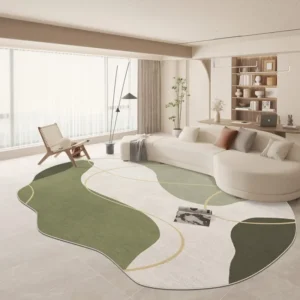 Large Area Green Rugs for Bedroom Nordic Living Room Decoration Shaped Carpet Irregular Plush Lounge Rug Home Thick Washable Mat
Rated 5.00 out of 5$54.94 – $346.41Price range: $54.94 through $346.41
Large Area Green Rugs for Bedroom Nordic Living Room Decoration Shaped Carpet Irregular Plush Lounge Rug Home Thick Washable Mat
Rated 5.00 out of 5$54.94 – $346.41Price range: $54.94 through $346.41 -
 Nordic Style Rugs for Bedroom Morandi Living Room Decoration Carpet Large Area Geometry Lounge Rug Home Cloakroom Non-slip Mat
Rated 5.00 out of 5$39.46 – $597.66Price range: $39.46 through $597.66
Nordic Style Rugs for Bedroom Morandi Living Room Decoration Carpet Large Area Geometry Lounge Rug Home Cloakroom Non-slip Mat
Rated 5.00 out of 5$39.46 – $597.66Price range: $39.46 through $597.66 -
 Irregular Shapes Living Room Decoration Carpet Modern Style Rugs for Bedroom Home Thicken Plush Rug Fluffy Soft Lounge Floor Mat
Rated 4.83 out of 5$55.84 – $347.37Price range: $55.84 through $347.37
Irregular Shapes Living Room Decoration Carpet Modern Style Rugs for Bedroom Home Thicken Plush Rug Fluffy Soft Lounge Floor Mat
Rated 4.83 out of 5$55.84 – $347.37Price range: $55.84 through $347.37

